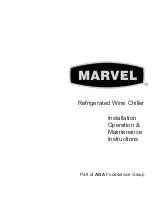
4/5
www.artevino.fr
If your door is glazed, never place it on its side
as it may break.
(to be carried out only when the cabinet is empty)
.The air vent
.Rotation of the door
.Access to the plug
.Glass door
Changing the hinges
Do not
obstruct
A
B
The plug must be accessible after the appliance
has been installed.
Adjusting the feet and securing the cabinet
N.B.!
- Gently remove the caps using a thin blade.
- Unscrew the three screws (1) using a T25 Torx
wrench.
- Remove the hinge (2).
- On the other side, gently remove the caps using a
thin blade (3).
- Assemble (4) the hinge with pin (B) using the
screws (5) in such a way that the door is completely
parallel to the body.
- Assemble (6) the hinge without pin (A) using the
screws (7). When you close the door, ensure that
the seal adheres well to the body to guarantee
air tightness.
The wine cabinet’s 4 feet can be adjusted in height.
- If necessary, use the hexagonal raising pieces (8) supplied in the “accessories” sachet. Tilt the appliance forwards, ensuring that
the door remains shut.
Unscrew the back feet and fit the raising pieces, using a 17 mm open-ended spanner.
Screw the 2 back feet onto the raising pieces.
Repeat the procedure for the 2 front feet, this time tilting the appliance backwards.
- Use suitable screws to secure the wine cabinet underneath the work top or inside the unit via the holes provided in the hinges.
Never obstruct the front air vent.
This could result in poor functioning
of the cabinet.
On the side of the axis of rotation of the
door, position it at least 3 mm from the
adjacent unit.
1
2
3
4
5
6
7
Cosy range
Flush-fitting diagrams
Small (S) size- Glass door
43
8



















